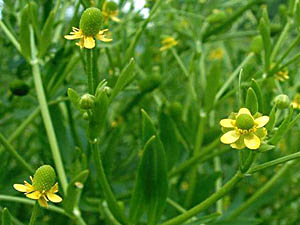
medicinal herbs
Celery-Leaved Buttercup
Ranunculus sceleratus

Herb: Celery-Leaved Buttercup
Latin name: Ranunculus sceleratus
Family: Ranunculaceae (Buttercup Family)
Medicinal use of Celery-Leaved Buttercup:
The celery-leafed buttercup is one of the most virulent of our native plants. The whole plant is acrid, anodyne, antispasmodic, diaphoretic and emmenagogue and rubefacient. When bruised and applied to the skin it raises a blister and creates a sore that is by no means easy to heal. If chewed it inflames the tongue and produces violent effects. The herb should be used fresh since it loses its effects when dried. The leaves and the root are used externally as an antirheumatic. The seed is tonic and is used in the treatment of colds, general debility, rheumatism and spermatorrhoea.Description of the plant:

Plant:
Perennial
Height:
60 cm(2 feet)

Flowering:
May toSeptember
Habitat of the herb:
In and by slow streams, ditches and shallow ponds of mineral rich water and muddy bottoms, avoiding acid soils.Edible parts of Celery-Leaved Buttercup:
Young plant cooked. It is said to be not unwholesome if the plant is boiled and the water thrown away and then the plant cooked again. Caution is strongly advised, see the notes above on toxicity and below on medicinal uses.Other uses of the herb:
An extract of the leaves can be used as a fungicide.Propagation of Celery-Leaved Buttercup:
Seed - sow spring in a cold frame. This plant is unlikely to need much assistance. Division in spring.Cultivation of the herb:
In and by slow streams, ditches and shallow ponds of mineral rich water and muddy bottoms, avoiding acid soils.Known hazards of Ranunculus sceleratus:
All parts of the plant are poisonous when fresh, the toxins are destroyed by heat or by drying. The plant also has a strongly acrid juice that can cause blistering to the skin.Plant information taken from the Plants For A Future.
